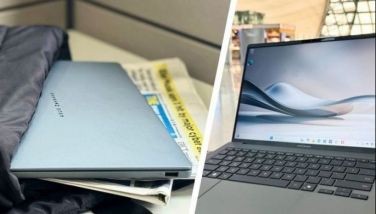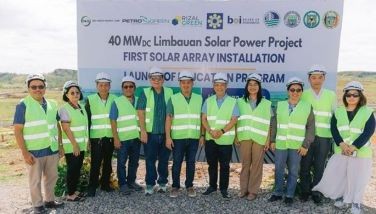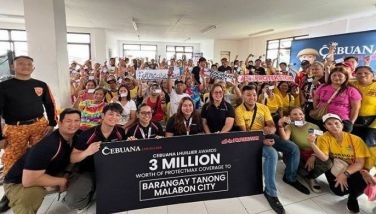Remembering Remedios … 'Paniid sa Bayot Sugboanon'
I didn't expect that my recent trip to the Cebuano Studies Center, located at the University of San Carlos - Talamban, would be so revealing and instructive, inspiring actually. Joined by esteemed social chronicler Gavin Sanson Bagares, I went to the center to learn more about my paternal great-grandmother Remedios Duterte-Del Mar, mother of my grandmother Caridad Duterte Del Mar-Lopez.
It's been over three years since I embarked on a mission to find out more about Lola Meding, and to hopefully find a photograph of hers. Buried at the crypt behind the main altar of the Basilica Minore del Santo Niño (which we visit from time to time), she is probably the most mysterious and elusive of my forebears, all the rest having at least a photograph or two for us to remember them by (the oldest photograph would be that of Don Francisco Lopez—our founding forebear who came to the Philippines from Granada, Spain—from the mid-1800s).
So when writer and poet Dr. Hope Sabanpan- Yu, director of the Cebuano Studies Center, showed me a photograph of Remedios during the dramatic reading of Linda Faigao-Hall's books at the Waterfront Hotel two weekends ago, one that was luckily on their DSLR camera, I decided it was finally time to see what else the CSC had to offer in my mission to find the few missing pieces to my family's colorful and storied puzzle.
I learned that, apart from being the first Carnival Queen of Cebu (according to the accounts of surviving members of the Lopez side of our family), and a socialite in the 1920s (according to University of Michigan's Michael Cullinane, noted historian on Cebu), Remedios was in fact a pioneering female journalist, a fiction writer for this very same paper—The Freeman. Talk about full circle.
And this Duterte- Del Mar heritage is especially important to me since it's our only link to Cebu—apart from having lived here since I was seven years old-an actual claim to being Cebuano (a quarter Cebuano, technically, my father being half-Cebuano). The rest of my grandparents and great-grandparents are from all over the place-Manila, Pampanga, Leyte, Surigao, Bulacan, et. al.
But I will write more about the trailblazing Remedios some other time, when I find out more about her and her work; hopefully a feature with old photos and quotes from articles/stories published. For now, let me share with you some fascinating finds scouring through old issues of The Freeman nearly a century old.
Articles from the early 1930s, more than a decade before World War II broke, reveal a Cebu very progressive, very forward, risqué even.
A precursor to today's Ear, Sabrina or Siloy blind items was made through the pseudonym “Bayot Sugboanon.†Can you imagine, “Bayot Sugboanon†or 'Gay Cebuano'?! The use of the word 'bayot' by publications today may be seen as too forthright at best, derogatory, salacious, and scandalous at worst. But more than peddling gossip, Bayot Sugboanon provided serious commentary, observations on how life was, how government rendered its services, as well as opinion on the politics of Cebu and the regions.
“Mga Lalawiganon Nga Paniid: Sinulat ni Bayot Sugboanon†& “Katapusang Kisaw Sa Dabaw: Paniid sa Usa ka Bayot Sugboanon†read some of his headlines–fascinating, just fascinating! Apart from this openness toward gay culture in Cebu's early print media, feminist views also saw print.
Another pioneering female Cebuano writer, a contemporary of our Lola Meding in The Freeman, Sofia de Veyra (I was told that she's the grandmother of ChinggayUtzurrum, among Cebu's respected society columnists) wrote an article on the modern woman of 1931 Cebu, its title: “Ang mga Babayeng Bag-ong Tubo Dili Na Pabintaha sa Lalaki†(In English, the woman of today are not subservient or inferior to men anymore, or something to that effect). “Musul-ob na sa bating-siyut, miuban na sa politika, milupad na sa kahanginan sakay sa ayroplano, ug karon buot usab mobotar.†(They wear bathing suits, participate in politics, fly on airplanes, and want to vote.)
I just love that female columnists of the time championed the cause of women so articulately, and that Cebu society before the war already welcomed and embraced this advancing and empowering school of thought.
And what was showing in Oriente cinema on February 8, 1931? “HOT CURVES!†Now how's that for kinaraan? I came across these illuminating articles in just an hour of going through old issues of The Freeman, so I commit to spend more time at the Cebuano Studies Center, not just to learn about my forebears–one of them is great-granduncle Mityong Del Mar, a pioneering and prominent gay interior designer who already had “kilay 2000†in the 1930s (discovering his photo probably titillated Gavin Bagares the most, LOL)—but to learn more about how Cebu was, especially in relation to how it is now, and to what else it can become.
***
www.facebook.com/MikeAcebedoLopez
Email: mikeacebedolopez@gmail.com
Twitter: @MykLopez
- Latest
























